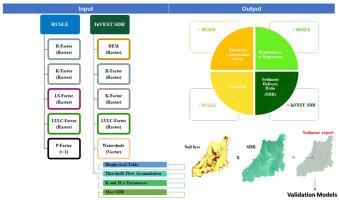Estimation and assessment of water erosion in the Peixe Angical basin, Brazil
IF 1.7
4区 地球科学
Q3 GEOSCIENCES, MULTIDISCIPLINARY
引用次数: 0
Abstract
Water erosion causes the displacement of soil particles from higher to lower elevations, and this process intensifies when land use and vegetation cover change, such as through the conversion of forests into pastures or agricultural fields. Identifying priority areas for soil and water conservation practices is essential for promoting sustainable agriculture. Equally important is identifying the most influential factors driving erosion, as understanding these can guide effective land management strategies. Machine learning techniques, such as Random Forest, are valuable tools for analyzing large datasets and assessing the importance of variables. The primary aim of this study was to estimate soil losses due to land-use changes in the Peixe Angical Reservoir drainage basin using the Revised Universal Soil Loss Equation (RUSLE) within a Geographic Information System (GIS) framework, and to identify priority areas for soil conservation. Additionally, the study aimed to evaluate the contribution and importance of the RUSLE model factors (R, K, LS, and C) to soil loss using the Random Forest regression algorithm. Soil losses were computed for the chronological scenarios (1990, 2000, 2010, and 2017), using rasters with 90 m resolution to calculate the product of the R, K, LS, and C factors, along with the P factor. These soil losses were classified into erosion risk categories, ranging from very low (0–2.5 Mg ha−1 yr−1) to extremely high (greater than 100 Mg ha−1 yr−1). Soil losses in the basin increased over time. The Random Forest algorithm was applied to evaluate the importance of each factor. Rainfall erosivity was found to vary spatially, ranging from 7047.64 MJ mm ha−1 h−1 yr−1 to 11,348.5 MJ mm ha−1 h−1 yr−1, while the LS factor exhibited values ranging from near 0 to over 20. Litholic Neosol (Entisol) was the predominant soil type in the drainage basin. In terms of land use, forests accounted for the largest portion of the basin: 55.60% in 1990, 51.31% in 2000, 48.88% in 2010, and 48.21% in 2017. The C factor, which reflects vegetation cover, was the most significant contributor to soil loss, accounting for 44.8% in 1990, 43.5% in 2000, 44.2% in 2010, and 44.4% in 2017, followed by the K factor (soil erodibility). These assessment techniques can be utilized in guiding conservation planning, thereby supporting sustainable land use practices.

估算和评估巴西 Peixe Angical 盆地的水蚀情况
水土流失会导致土壤颗粒从高处向低处迁移,当土地利用和植被发生变化时,如将森林转化为牧场或农田,这一过程就会加剧。确定水土保持实践的优先区域对于促进可持续农业至关重要。同样重要的是确定造成侵蚀的最有影响力的因素,因为了解这些因素可以指导有效的土地管理策略。随机森林等机器学习技术是分析大型数据集和评估变量重要性的重要工具。本研究的主要目的是在地理信息系统(GIS)框架内使用修订的通用土壤流失方程(RUSLE)估算 Peixe Angical 水库流域因土地利用变化造成的土壤流失,并确定土壤保护的优先区域。此外,该研究还旨在利用随机森林回归算法评估 RUSLE 模型因子(R、K、LS 和 C)对土壤流失的贡献和重要性。利用分辨率为 90 米的栅格计算 R、K、LS 和 C 因子与 P 因子的乘积,计算了年代情景(1990 年、2000 年、2010 年和 2017 年)下的土壤流失量。这些土壤流失量被划分为侵蚀风险类别,从极低(0-2.5 兆克/公顷-年-1)到极高(大于 1 亿克/公顷-年-1)不等。该流域的土壤流失量随时间推移而增加。采用随机森林算法评估了各因素的重要性。发现降雨侵蚀率在空间上存在差异,从 7047.64 兆焦耳毫米公顷-1 小时-年-1 到 11348.5 兆焦耳毫米公顷-1 小时-年-1,而 LS 因子的值从接近 0 到超过 20 不等。石质新溶岩(Entisol)是该流域最主要的土壤类型。在土地利用方面,森林在流域中所占比例最大:1990 年为 55.60%,2000 年为 51.31%,2010 年为 48.88%,2017 年为 48.21%。反映植被覆盖率的 C 因子是造成土壤流失的最主要因素,1990 年占 44.8%,2000 年占 43.5%,2010 年占 44.2%,2017 年占 44.4%,其次是 K 因子(土壤可侵蚀性)。这些评估技术可用于指导保护规划,从而支持可持续的土地利用实践。
本文章由计算机程序翻译,如有差异,请以英文原文为准。
求助全文
约1分钟内获得全文
求助全文
来源期刊

Journal of South American Earth Sciences
地学-地球科学综合
CiteScore
3.70
自引率
22.20%
发文量
364
审稿时长
6-12 weeks
期刊介绍:
Papers must have a regional appeal and should present work of more than local significance. Research papers dealing with the regional geology of South American cratons and mobile belts, within the following research fields:
-Economic geology, metallogenesis and hydrocarbon genesis and reservoirs.
-Geophysics, geochemistry, volcanology, igneous and metamorphic petrology.
-Tectonics, neo- and seismotectonics and geodynamic modeling.
-Geomorphology, geological hazards, environmental geology, climate change in America and Antarctica, and soil research.
-Stratigraphy, sedimentology, structure and basin evolution.
-Paleontology, paleoecology, paleoclimatology and Quaternary geology.
New developments in already established regional projects and new initiatives dealing with the geology of the continent will be summarized and presented on a regular basis. Short notes, discussions, book reviews and conference and workshop reports will also be included when relevant.
 求助内容:
求助内容: 应助结果提醒方式:
应助结果提醒方式:


